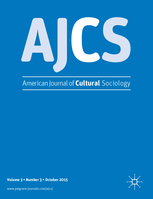|
This month our inaugural guest edited special issue, on the cultural sociology of reading, went to print. We are now working with Lisa McCormick (University of Edinburgh) on the second issue in our guest curated series, a special issue on the cultural sociology of music and art, forthcoming early 2022, and we are pleased to announce that the first article from this issue is now available to read (and share) for free OnlineFirst! To view and read Amy Whitaker and Fiona Greenland’s “Theory of an Art Market Scandal: Artistic Integrity and Financial Speculation in the Inigo Philbrick Case,” visit https://rdcu.be/cmGDl. For your convenience, an abstract summary is included below. For a more leisurely read on the subject, check out their recent op-ed available at ArtNet News. Theory of an Art Market Scandal: Artistic Integrity and Financial Speculation in the Inigo Philbrick Case” Focusing on the case of Inigo Philbrick and his alleged fraudulent overselling of artworks by Rudolf Stingel, we offer a new theory of art market scandal that builds upon Alexander’s framework of the pure and impure, and Adut’s concept of transgressive publicity. We argue that the presence of an art market creates latent impurity, according to the Hostile Worlds conception of markets as an impurification of art. The further financialization of an artwork into shares redoubles money’s impurification of art by creating what we term a financial simulacrum. Philbrick’s case allows us to expand Adut’s theory from mapping an art scandal of moral decency to conceptualizing an art market scandal of financial transgression. We argue that financial transgression—as enabled by the increased securitization of art—depends on the persona of the art dealer as intermediary, a projection that is itself a simulacrum. Thus, we frame Philbrick archetypally as hydroponic, validated, novel yet neutral, and self-pardoning. Drawing on interviews of expert insiders and close reading of court documents and press articles, we contribute a model of art market scandal that encompasses the dual artistic and financial nature of traded artworks and the shared art-industry risk of regulation. |
Theory of an Art Market Scandal

Follow and share: